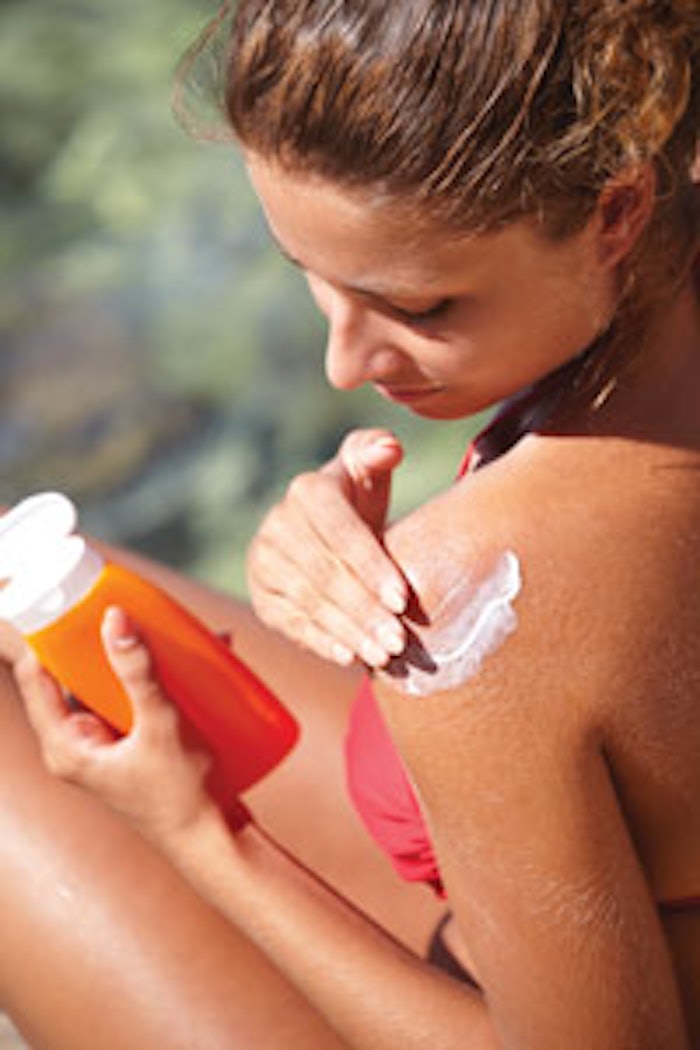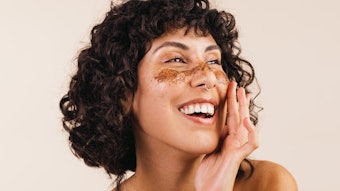
The loss of facial volume is a key contributor to an aged facial appearance. Although some of the visible loss of facial volume is due to reduced facial fat and the resorption of bones, you may be able to help clients potentially avoid resorting to a face lift, which simply stretches and removes excess tissue, by implementing topical cosmeceuticals that work to protect existing volume, and replace epidermal and dermal matrix volume that has already been lost. Although minimally invasive injectables are the gold standard once adipose tissue and bone mass have been lost, there are many proven ingredients and product categories that can be added to a client’s daily regimen to help preserve, maintain and increase the facial volume of the skin—and your clients’ youthful appearance.
The physiology of facial volume loss
The primary cause of visible facial aging of the skin is matrix degradation. The extracellular matrix (ECM) is a complex framework of biomolecules that support and protect dermal cells. The ECM is made up of structural proteins (collagen and elastin), adhesive proteins (laminins and fibronectin), glycosaminoglycans (GAGs) and proteoglycans. These components are all vitally important for a full, youthful appearance that is free of laxity, wrinkling and poor surface texture. The breakdown of these all-important structures is a result of both intrinsic aging that happens due to time and genetics, and extrinsic aging, which is largely avoidable.
The offending extrinsic factors
Although ECM-breakdown occurs naturally with the passage of time, it is accelerated by external factors, primarily UV exposure. The oxidative stress instigated by UV rays increases matrix metalloproteinase (MMP) production—the enzymes that breakdown the ECM. These enzymes are increased with as little as 0.1 minimal erythema dose (MED), which is one-tenth of the UV exposure it takes for skin to become red. This demonstrates the critical nature of the daily, year-round use of broad-spectrum sun protection; you don’t need to tan to begin the cascade of facial volume loss. (Editor’s note: See the article “Sunscreens: What You (and Your Clients) Must Know” in the May 2014 issue.)
Free radical formation is also increased with UV exposure. It is well-documented that UVB rays specifically instigate a cascade that leads to the creation of highly reactive radicals that have unpaired electrons in their outer shell. There are a variety of types of free radicals, yet reactive oxygen species (ROS) are widely studied, due to their proven damaging effects on the skin.
The aged appearance that occurs due to the loss of facial volume is compounded by the atrophy of both the epidermis and the dermis. It has been demonstrated that the drop in estrogen levels during perimenopause and menopause slows the production of matrix components. In addition to the degradation of mature collagen already mentioned due to UV exposure, it has also been demonstrated that UV rays compound facial volume loss by inhibiting the expression of the genes responsible for the formation of new collagen—both type I and type II procollagen. This dermal atrophy contributes substantially to visible facial aging.
Ingredients for fighting facial volume loss
It is important to address the production of matrix components when designing a strategy for aging clients. That said, the protection of the existing ECM is critical. Two key categories for ECM protection are broad-spectrum sunscreen and antioxidants.
Broad-spectrum sunscreen. Because sunscreens can limit UV-induced skin damage and MMP production, they are widely accepted as the most beneficial of all categories of anti-aging products. A truly effective broad-spectrum sunscreen must contain ingredients that protect against both UVA rays, such as zinc oxide, avobenzone, ecamsule or titanium dioxide; and UVB rays, such as cinnamates, salicylates or titanium dioxide. New U.S. Food and Drug Administration (FDA) sunscreen labeling regulations put in place in 2012 set forth more stringent testing requirements. In order for a product to be labeled “broad spectrum,” it must undergo specific testing to prove that it sufficiently protects across the entire UV spectrum. Educating clients about the integral nature of daily sunscreen use typically increases compliance. Additionally, there are now cosmetically elegant daytime SPF products available that will increase the likelihood that a client will use sunscreen regularly. Some are also formulated with added antioxidants to further increase the protection of matrix components.
Antioxidants. Antioxidants are a vital part of any regimen designed to fight facial volume loss. The human body does have its own internal free radical-fighting system, but the daily use of topically applied antioxidants significantly improves the level of protection provided to the dermis, thereby reducing the loss of facial volume. There are three distinct categories of antioxidants, although some function in multiple categories. Primary antioxidants donate electrons to free radicals, rendering them harmless; secondary antioxidants chelate metal ions; and co-antioxidants facilitate the action of other antioxidants. Below are some key antioxidants to add into the regimens of facial volume loss clients.
- Primary antioxidants—L-ascorbic acid, resveratrol, tea polyphenols, vitamin E, glutathione, silybin, ferulic acid, idebenone and coffea arabica extract
- Secondary antioxidants—L-ascorbic acid, silybin, caffeine and resveratrol
- Co-antioxidants—L-ascorbic acid, vitamin E and glutathione
Adding topical MMP-inhibiting ingredients (MMPi) is another excellent protective step for preserving facial volume. These ingredients prevent the over-activity of the MMP responsible for breaking down valuable and necessary matrix components. Many MMPi are also proven antioxidants, making some of these ingredients key in any regimen designed to fight facial volume loss.
- Aloe vera
- Beta-carotene
- Epigallocatechin gallate (EGCG)
- L-ascorbic acid (vitamin C)
- Resveratrol
- Retinoids
- Soy isoflavones
- Vitamin E
Matrix production
Using topical ingredients proven to stimulate the production and deposition of matrix components—primarily collagen—is an important step toward building facial volume and enhancing a youthful appearance.
Peptides. Peptides are an important ingredient category for these purposes. A peptide is a compound consisting of two or more amino acids, which are the building blocks of proteins. Peptides act as transmitters from the brain to the body, telling the muscles and nerves to perform specific functions. There are multiple peptides available that will achieve different results when used topically. Those that trigger the deposition of dermal components are the most critical to a regimen designed to build facial volume, and include the following.
- Palmitoyl tripeptide-38—Stimulates the production of collagen I, III and IV; fibronectin; hyaluronic acid; laminin-5; and heat shock protein 47 (HSP47), a chaperone protein that ensures these other important matrix components successfully reach maturity.
- Palmitoyl tripeptide-5—Increases collagen deposition.
- Palmitoyl tetrapeptide-7—Improves skin firmness and elasticity.
- Palmitoyl pentapeptide-4—Increases collagen I and IV.
- Palmitoyl oligopeptide—Stimulates collagen production.
- Palmitoyl oligopeptide-palmitoyl tetrapeptide-7—Stimulates the production of multiple ECM components.
Retinoids. Retinoids include retinol, retinaldehyde, vitamin A esters, retinoic acid and its analogues. Although retinoic acid is the biologically active and most potent retinoid, it can be topically irritating to some clients. Pure retinol is a good alternative, because it effectively binds with cellular retinol binding protein (CRBP) and is ultimately converted to retinoic acid in the skin without causing irritation. Retinol, retinaldehyde and retinoic acid are proven to stimulate dermal fibroblast production, increase messenger RNAs (mRNAs) for types I and III collagen, and trigger GAG production when applied topically. Additionally, retinoids are thought to be one of the only topical ingredients that encourage the proliferation of elastin.
L-ascorbic acid. L-ascorbic acid, the bioavailable form of vitamin C, is a co-factor for collagen-stabilizing enzymes prolyl and lysyl hydroxylase, and activates and stabilizes procollagen mRNA, leading to collagen deposition. Although esters, such as ascorbyl palmitate and magnesium ascorbyl phosphate, are beneficial when administered orally, the acids in the skin are not strong enough to cleave the ester’s covalent bonds to free the L-ascorbic acid. Therefore, for topical use, L-ascorbic acid is preferred to maximize collagen production. The vitamin C esters do provide antioxidant activity, but only L-ascorbic acid provides the needed anti-aging activity crucial to building facial volume.
Worth the effort
By educating clients of all ages about what a strong impact their efforts have on preserving their youthful appearance, you can increase compliance. Although the earlier a client begins protecting and replacing ECM components, the better the outcomes will be, it is never too late to start a regimen to protect and produce facial volume. As clients move from their 40s into their 50s and 60s, some may opt for the addition of highly effective injectable fillers, such as poly l-lactic acid and hyaluronic acid, to replace lost volume. However, the topical strategies should be maintained nonetheless. Some may resort to surgical procedures to remove excess tissue, but remember that a young face is a full face, so simply removing tissue will not provide the youthful look they desire. Following the above guidelines for combating facial volume loss should be an integral part of every aging client’s regimen, regardless of whether they opt for surgery later in life. Using time-tested, proven topicals can make a dramatic difference in clients’ facial volume and their appearance.
Jennifer Linder, MD, is a dermatologist and Mohs micrographic skin surgeon, serving as CSO for PCA Skin. She holds a clinical faculty position in the department of dermatology at the University of California, San Francisco; is a spokesperson for The Skin Cancer Foundation; and is a member of the American Academy of Dermatology (AAD), the American Society for Dermatologic Surgery (ASDS), and the American College of Mohs Micrographic Surgery and Cutaneous Oncology (ACMMSCO).










